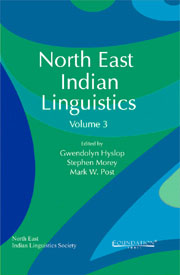Book contents
- Frontmatter
- Contents
- About the Contributors
- Foreword
- A Note from the Editors
- The View from Manipur
- The Sal Group
- Tibeto-Burman Nominalization
- Tani
- Eastern Indo-Aryan
- 11 The Referring Systems and the Determinative Elements of Noun Phrases in Assamese
- 12 Copular Sentences in Asamiya
- 13 Case Marking in Hajong
- Austroasiatic
12 - Copular Sentences in Asamiya
from Eastern Indo-Aryan
Published online by Cambridge University Press: 26 October 2011
- Frontmatter
- Contents
- About the Contributors
- Foreword
- A Note from the Editors
- The View from Manipur
- The Sal Group
- Tibeto-Burman Nominalization
- Tani
- Eastern Indo-Aryan
- 11 The Referring Systems and the Determinative Elements of Noun Phrases in Assamese
- 12 Copular Sentences in Asamiya
- 13 Case Marking in Hajong
- Austroasiatic
Summary
Introduction
Copular constructions have since long drawn the attention of scholars engaged in explorative studies of a particular language or across languages because of the intriguing features that set copular constructions apart from other types of constructions in language(s). The term “copula” (COP), as a constituent of a copular construction, has been used in typological studies to refer to any morpheme (affix, particle or verb) that links or “couples” a subject with a copula complement in a “family” of constructions, collectively often referred to as “predicate nominal constructions” (Payne 1997: 111–14). In contrast to the dimension of verb complementation distinguished in terms of the number of objects present, a copular construction, characterized by a copula, contains an obligatory copula complement (CC)/predicative complement (PC), predicated of the copula subject (CS) (Dixon 2004; Huddleston & Pullum 2002). Cross-linguistically, “the most basic copular construction” is used to encode the meanings of classification (inclusion/group membership) or identification (specification/equation of two participants “normally encoded as noun phrases,” others being “less basic” (Curnow 2000: 2). Typological studies show that besides that of inclusion and equation, copular sentences are used to express other assertions like that of location, attribution, possession or existence of a referent (Payne 1997; Declerck 1988; Pustet 2003). The distinctively different categories of overt copulas that have been attested across languages are mostly verbal, pronominal and particle (Stassen 1997: 85, cited in Pustet 2003: 45; Payne 1997: 118–119).
- Type
- Chapter
- Information
- North East Indian Linguistics , pp. 197 - 222Publisher: Foundation BooksPrint publication year: 2011



